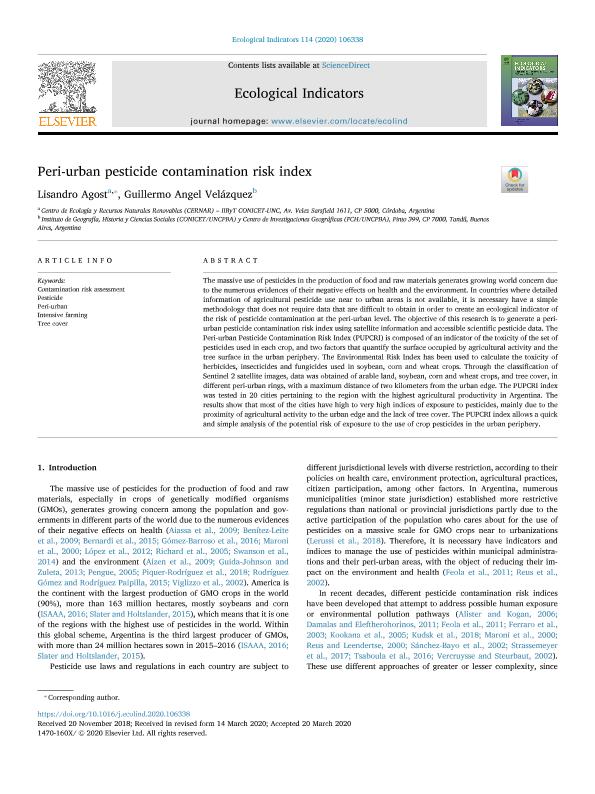Mostrar el registro sencillo del ítem
dc.contributor.author
Agost, Lisandro

dc.contributor.author
Velázquez, Guillermo Ángel

dc.date.available
2021-10-14T20:26:19Z
dc.date.issued
2020-07
dc.identifier.citation
Agost, Lisandro; Velázquez, Guillermo Ángel; Peri-urban pesticide contamination risk index; Elsevier; Ecological Indicators; 114; 7-2020; 1-11
dc.identifier.issn
1470-160X
dc.identifier.uri
http://hdl.handle.net/11336/143691
dc.description.abstract
The massive use of pesticides in the production of food and raw materials generates growing world concern due to the numerous evidences of their negative effects on health and the environment. In countries where detailed information of agricultural pesticide use near to urban areas is not available, it is necessary have a simple methodology that does not require data that are difficult to obtain in order to create an ecological indicator of the risk of pesticide contamination at the peri-urban level. The objective of this research is to generate a periurban pesticide contamination risk index using satellite information and accessible scientific pesticide data. The Peri-urban Pesticide Contamination Risk Index (PUPCRI) is composed of an indicator of the toxicity of the set of pesticides used in each crop, and two factors that quantify the surface occupied by agricultural activity and the tree surface in the urban periphery. The Environmental Risk Index has been used to calculate the toxicity of herbicides, insecticides and fungicides used in soybean, corn and wheat crops. Through the classification of Sentinel 2 satellite images, data was obtained of arable land, soybean, corn and wheat crops, and tree cover, in different peri-urban rings, with a maximum distance of two kilometers from the urban edge. The PUPCRI index was tested in 20 cities pertaining to the region with the highest agricultural productivity in Argentina. The results show that most of the cities have high to very high indices of exposure to pesticides, mainly due to the proximity of agricultural activity to the urban edge and the lack of tree cover. The PUPCRI index allows a quick and simple analysis of the potential risk of exposure to the use of crop pesticides in the urban periphery.
dc.format
application/pdf
dc.language.iso
eng
dc.publisher
Elsevier
dc.rights
info:eu-repo/semantics/openAccess
dc.rights.uri
https://creativecommons.org/licenses/by-nc-nd/2.5/ar/
dc.subject
CONTAMINATION RISK ASSESSMENT
dc.subject
PESTICIDE
dc.subject
PERI-URBAN
dc.subject
INTENSIVE FARMING
dc.subject
TREE COVER
dc.subject.classification
Ciencias Medioambientales

dc.subject.classification
Geografía Económica y Social

dc.subject.classification
CIENCIAS SOCIALES

dc.title
Peri-urban pesticide contamination risk index
dc.type
info:eu-repo/semantics/article
dc.type
info:ar-repo/semantics/artículo
dc.type
info:eu-repo/semantics/publishedVersion
dc.date.updated
2021-09-27T15:24:40Z
dc.journal.volume
114
dc.journal.pagination
1-11
dc.journal.pais
Países Bajos

dc.description.fil
Fil: Agost, Lisandro. Consejo Nacional de Investigaciones Científicas y Técnicas. Centro Científico Tecnológico Conicet - Córdoba. Instituto de Investigaciones Biológicas y Tecnológicas. Universidad Nacional de Córdoba. Facultad de Ciencias Exactas, Físicas y Naturales. Instituto de Investigaciones Biológicas y Tecnológicas; Argentina
dc.description.fil
Fil: Velázquez, Guillermo Ángel. Consejo Nacional de Investigaciones Científicas y Técnicas. Centro Científico Tecnológico Conicet - Tandil. Instituto de Geografía, Historia y Ciencias Sociales. Universidad Nacional del Centro de la Provincia de Buenos Aires. Instituto de Geografía, Historia y Ciencias Sociales; Argentina
dc.journal.title
Ecological Indicators

dc.relation.alternativeid
info:eu-repo/semantics/altIdentifier/url/https://www.sciencedirect.com/science/article/abs/pii/S1470160X20302752?via%3Dihub
dc.relation.alternativeid
info:eu-repo/semantics/altIdentifier/doi/http://dx.doi.org/10.1016/j.ecolind.2020.106338
Archivos asociados
